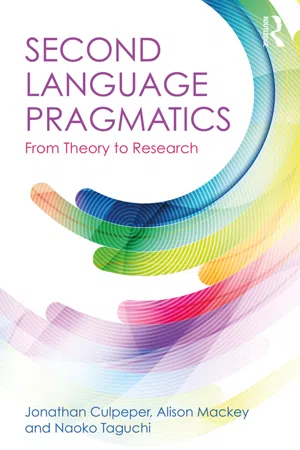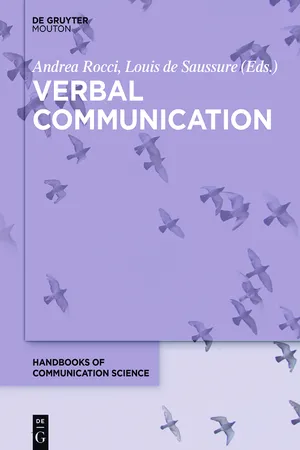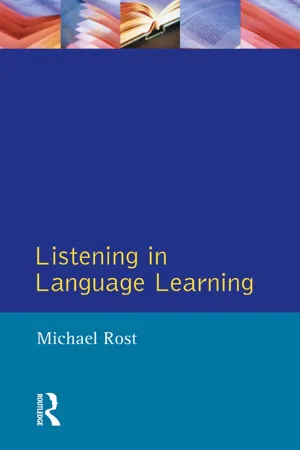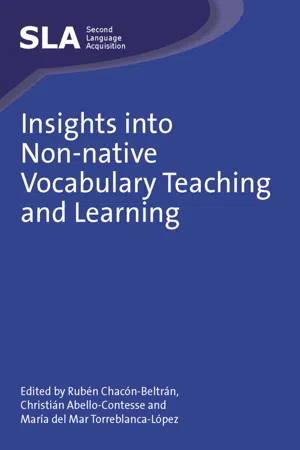Languages & Linguistics
Inference
Inference refers to the process of drawing conclusions or making educated guesses based on available evidence or information. In linguistics, inference plays a crucial role in understanding the meaning of language, as it involves using contextual and linguistic cues to fill in gaps and make sense of ambiguous or incomplete information. This process is essential for comprehension and communication in language.
Written by Perlego with AI-assistance
Related key terms
6 Key excerpts on "Inference"
- eBook - ePub
- Timothy Chan, Anders Nes(Authors)
- 2019(Publication Date)
- Routledge(Publisher)
The plan for the chapter is as follows. In Section 2 I specify what I mean by the term ‘Inference’ and look at the types of valid or otherwise legitimate Inferences speakers typically make. In Section 3 I look closer at what it means to say that a meaning property is presented in experience. In Section 4 I provide my main arguments for thinking that we frequently perceive apparently conveyed meanings.2. Linguistic Inferences
Before examining what exactly it means to say that a meaning property is presented in sensory experience and defending the view that they are sometimes thus presented, let’s have a closer look at the nature of linguistic Inference. Before saying something about linguistic Inference, however, we need to be clear on what an Inference is.One might suggest that an Inference is a process during which a system transitions from the informational content of a state (e.g., a computational, mental or neurological state) to the informational content of another – in accordance with a particular rule set.4 This definition is clearly too broad. It allows us to truly say of an unconscious machine that it makes Inferences as long as it computes information. It also classifies many brain computations that intuitively are not Inferences as Inferences. Here is an example of a process that is not consciously accessible yet would count as an Inference on the broad definition of ‘Inference’ (for discussion, see Brogaard, 2011a). When you reach to and grasp your coffee mug, you automatically fold your fingers in a particular way that fits the handle of the mug. This folding of your fingers is also known as ‘the hand aperture’. Your brain calculates the hand aperture it assumes will fit the mug. But there is no way you could reproduce these calculations on a conscious level. The process takes place below the level of conscious awareness and is inaccessible to consciousness. The calculation of the correct hand aperture does not involve you - eBook - ePub
Second Language Pragmatics
From Theory to Research
- Jonathan Culpeper, Alison Mackey, Naoko Taguchi(Authors)
- 2018(Publication Date)
- Routledge(Publisher)
Section 2.4 ., we also encountered meanings, including politeness meanings, that lie beyond what is in the surface form. Answering simply “yes” to the apparent question “Could you tell me the time?” would be perverse. These areas, though very important, are not the only cases involving meanings that go beyond what is said. An obvious reason for their frequent presence is economy of expression; we can rely on our hearers to fill in the gaps through inferencing. In fact, every utterance is open to some degree of inferencing, in the broadest sense of the word. This is regardless of language or culture, though precisely how that inferencing works may vary across cultures and is a topic of study in intercultural pragmatics.In the context of general pragmatics, four key terms involving meanings beyond the semantics of what is said are as follows:Related to the speaker:Imply: The speaker generates some meaning beyond the semantic meaning of the words.Implicature: The implied meaning generated intentionally by the speaker.Related to the hearer:Infer: The hearer derives meaning from available evidence.Inference: The inferred meaning derived by the hearer and which may or may not be the same as the speaker’s intended implicature.These four words and their definitions provide a useful categorization of different aspects of pragmatic meaning. However, a key point to note is that native speakers of English do not always follow these definitions. Quite often, for example, people use infer to mean imply. In this book, and indeed in most general pragmatics, usage follows what we have laid out above.The title of H. Paul Grice’s (1975) key paper is telling: “Logic and conversation.” Grice’s work focuses on the kind of “logical” inferencing characterized by mechanisms for drawing conclusions or implications from premises, as might be illustrated thus:[1] Premise 1: Plants die when they are not watered.Premise 2: Lilies are plants.Conclusion: Lilies will die when they are not watered.Grice set out to show that there is some kind of logical system operating in natural conversation for working out meanings beyond the semantics. It is not, however, quite the same as the logic in Example [1]. There we see the premises and conclusions that are typical of deductive logic. We are dealing with absolute truths (there is no fuzziness or doubt that “lilies are plants”). In contrast, the logic proposed for conversation is a kind of pseudo-logic based on assumptions that lead to probable conclusions. Conversational logic is often fuzzy and rarely leads to one definite conclusion, though hearers often settle on a single conclusion because of various contextual factors. We will discuss the assumptions that lead to these conclusions in the following section. - eBook - ePub
Pragmatics
A Multidisciplinary Perspective
- Louise Cummings(Author)
- 2013(Publication Date)
- Routledge(Publisher)
That some elaborative Inferences are more language dependent than other elaborative Inferences is clear from the findings of a recent investigation into the inferencing skills of aphasic subjects (Cummings 2000a). Aphasic and control (language-intact) subjects were read passages that were designed to elicit two types of elaborative Inference – instrument and consequence of action Inferences. These Inferences were chosen on account of what we now know to be their varying degrees of language dependence. In an attempt to address the issue of language dependence in Inference, two main comparisons were pursued. First, aphasic subjects’ performance on instrument Inferences was compared with their performance on consequence of action Inferences. Second, aphasic subjects’ performance on both types of Inference was compared with the performance of control subjects on these same Inferences. Statistical analyses revealed that instrument Inferences and consequence of action Inferences operate independently of each other in aphasic and control subjects and that aphasic subjects compute significantly fewer Inferences of both kinds than control subjects. The former finding is consistent with these Inferences operating according to two distinct psychological mechanisms, one of which is more language dependent than the other. The latter finding is explained by the language impairment of aphasic subjects. This impairment disrupts the normal language interactions of these Inferences, from strong language dependence in the case of instrument Inferences to the weaker language associations of consequence of action Inferences.Thus far, elaborative Inferences have been examined within the context of single sentences. However, more often than not these Inferences assume a discourse function within language by providing cohesive links within a text. As with previous elaborative Inferences, these discourse Inferences can be more or less dependent on language. In the following example, repeated here from above:John decided to go to the doctor. The doctor told him he had the flu and John picked up his medicine on the way out of the surgery.the Inference ‘The doctor prescribed some medicine’ is triggered by certain lexical items (e.g. doctor, flu, medicine) with which it is loosely associated. However, this Inference is generated ultimately by our knowledge of the routine activities of doctors and by our knowledge of the treatment of illness – that illness can be treated using medicines that only a doctor can prescribe. In the case of this Inference, real-world knowledge is used to link events that are described by the above sentences. In the case of the following bridging Inference (Clark 1977), however, the Inference is linking the sentences themselves:Mary unpacked the picnic supplies from the trunk. The beer was warm. The picnic supplies contained beer (bridging Inference).A listener or reader must be able to infer a bridge between the first two sentences above if information that is contained in the second of these sentences is to be incorporated into a semantic representation of the first sentence. Clark (1975) calls this type of Inference a backward Inference, because sentence processing is suspended temporarily, until the anaphor can be resolved by searching previous text for a suitable referent. Such a referent will be one that conforms to our knowledge of the world – in the above example, it is that the picnic supplies contain the beer that is described in the second sentence. However, while real-world knowledge establishes the content of this Inference, the primary function of this Inference is the integration of sentences within linguistic processing. - eBook - ePub
- Andrea Rocci, Louis de Saussure(Authors)
- 2016(Publication Date)
- De Gruyter Mouton(Publisher)
The cognitive turn in Pragmatics has brought findings in Psychology, Cognitive Neuroscience, Evolution and Artificial Intelligence to the foreground that can offer fruitful insights when combined with linguistic and philosophical considerations in an interdisciplinary approach. Grice’s work represented a turning point after which it is commonly assumed that recovering implicit meanings is a process crucially dependent on the speaker’s intentions, on the one hand, and on the integration of the information linguistically conveyed with other pieces of (background) information, on the other. Two main cognitive abilities are then involved in utterance interpretation: that of attributing intentions to the speaker and that of selecting contextual information and combining it with the meaning obtained by decoding. The next two sections provide a brief overview of the key processes and mechanisms from a cognitive perspective.5.1 Inferential processesUtterance interpretation can be seen as a matter of combining information from different sources (linguistic decoding, general world knowledge, background information) to identify and recover the set of assumptions that the speaker intended to communicate. Explaining the way in which this is achieved is the goal of a universal theory about how information is selected, combined and processed in our minds.In principle, there are no limits to the class or the amount of information that an individual can bring to bear in utterance interpretation. However, if this is so, the interpretive process would be an “intractable” problem from a computational point of view, i.e. one that would require a never-ending process of computing an infinity of variables. This seems far off from human processing capacities, which are known to be limited and slow. And yet we humans are usually very efficient in utterance interpretation: most of the times, we reach very accurate interpretive hypotheses in a very quick way almost instantaneously. This suggests that our processing mechanisms have found a way to circumvent that problem.5.1.1 Defeasible InferenceThe word usually holds the answer. We know that sometimes hearers make the wrong guess and misinterpret the speaker’s words: surely, this is something we have all experienced many times. This shows that the interpretation is, at most, usually right, but the process is not failsafe and does not per se guarantee the output (i.e. it is a non-demonstrative process). How is then spontaneous Inference to be modelled? There are various ways. Sperber & Wilson (1986/1995, 1987) advocate for a view in which utterance interpretation is indeed a non-demonstrative process, but it can contain deductive chains as sub-parts. Consider again the example in (1). The explicitly communicated assumption (repeated here as (26a) combines with an implicit premise in the form of a conditional claim ‘If there is nothing on TV, then we should go out’ to yield the conclusion ‘We should go out’ by using the modus ponens - eBook - ePub
- Michael Rost, C N Candlin(Authors)
- 2014(Publication Date)
- Routledge(Publisher)
3 Listener Inference 3.0 Introduction: understanding and misunderstanding This chapter outlines ways in which listeners form Inferences as they listen. Throughout the discussion reference will be made to principles (rather than rules) that allow discourse to be interpretable to a listener. It is shown why listeners must utilize inferencing in order to make sense of discourse, and a set of procedures is given that listeners use for editing discourse in order to organize what they hear. At the outset of this discussion, it is important to emphasize the principle of meaning as active knowledge construction, rather than as passive reception of information. Meaning in discourse is created by the listener within a personal knowledge domain. Meaning is created only by an active listening in which the linguistic form triggers interpretation within the listener's background and in relation to the listener's purpose, rather than conveying information. Background is then not only linguistic and pragmatic knowledge, but also a basic orientation toward the content of the discourse (Winograd and Flores, 1987). In this sense, the listener's background outlines the dimensions of what can be understood. In the discussion of understanding in this chapter (and in later chapters), four terms relating to listener construction of meaning will be used: acceptable understanding (AU), targeted understanding (TU), non-understanding (NU), and misunderstanding (MU). Non-understanding refers to the listener being unable to draw any appropriate Inference based on what a speaker has just said. Misunderstanding refers to a conflict between the type of Inferences that the speaker had expected the hearer to draw from the speaker's utterances and those Inferences that the hearer actually has drawn. Acceptable understanding refers to Inferences drawn by a listener that are satisfactory to both speaker and listener - Rubén Chacón-Beltrán, Christian Abello-Contesse, María del Mar Torreblanca-López(Authors)
- 2010(Publication Date)
- Multilingual Matters(Publisher)
Part 2 Empirical Studies on Lexical Processing in English and SpanishChapter 5 The Effect of Lexicalization in the Native Language on Second Language Lexical Inferencing: A Cross-Linguistic Study
T. SIMA PARIBAKHTIntroduction
Research indicates that lexical inferencing, or how one makes an informed guess about the contextual meaning of an unfamiliar word, is the main strategy that learners use when they encounter unfamiliar words when reading (Fraser, 1999; Paribakht & Wesche, 1999). It can also be the first step in learning a new word. Thus, given its crucial role in both second language (L2) reading comprehension and lexical development, a precise understanding of the process of inferencing and factors that contribute to its success is important for both theory and instruction.Previous studies have demonstrated that L2 readers use textual cues from all levels of language, interacting with their world knowledge in lexical inferencing (e.g. Ames, 1966; Bengeleil & Paribakht, 2004; Carton, 1971; Haastrup, 1991; Paribakht, 2005; Paribakht & Wesche, 1999). Research on the topic has also identified a number of learner, text and contextual factors that influence the success of L2 lexical inferencing. These include the importance of the word to text comprehension (Brown, 1993), the degree of textual information available in the surrounding text (Dubin & Olshtain, 1993), the learner ability to make effective use of extra-textual cues (de Bot et al. , 1997; Haastrup, 1991), the learners’ preconceptions about the possible meaning of the word and their attention to the details in the text (Frantzen, 2003), reading proficiency (Bengeleil & Paribakht, 2004; Haastrup, 1991), vocabulary recognition knowledge (Coady et al. , 1993; Laufer, 1997), and depth of vocabulary knowledge (Nassaji, 2004).Despite a large body of research on L2 lexical inferencing, little is known about the influence of the readers’ native language on the inferencing process. It is not yet clear how the readers’ first language (L1) knowledge may affect their use of various knowledge sources (KSs) in L2 lexical inferencing and their success in comprehending the target word meaning. Cross-lingual studies of L2 lexical processing have addressed the impact of differing orthographies (e.g. Chikamatsu, 1996; Ghahremani-Ghajar & Masny, 1999; Gholamain & Geva, 1999; Koda, 1989; Koda et al. , 1998). Other research has looked at the effect of cognate recognition (Ard & Holmburg, 1983; Hancin-Bhatt & Nagy, 1994; Tréville, 1996), as well as L1 syntactic effects on L2 lexical inferencing (e.g. Nagy et al.
Learn about this page
Index pages curate the most relevant extracts from our library of academic textbooks. They’ve been created using an in-house natural language model (NLM), each adding context and meaning to key research topics.





